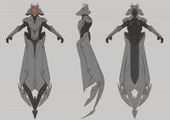Combat skin: Difference between revisions
From Halopedia, the Halo wiki
mNo edit summary |
Sith Venator (talk | contribs) |
||
| (81 intermediate revisions by 48 users not shown) | |||
| Line 1: | Line 1: | ||
{{ | {{Status|Canon}} | ||
{{ | {{Cleanup}} | ||
[[File: | [[File:H4 - Warrior-Servants 2.jpg|thumb|250px|Forerunners wearing combat skins.]] | ||
'''Combat | '''Combat skins''', also known as '''fighting suits''' or '''battle armor''', were a type of [[Forerunner personal armor|body armor]] used by [[Forerunner]] combat personnel. The Forerunners had a classification system for combat skins, running from Class 1 to Class 18, and possibly above. According to [[343 Guilty Spark]], the [[human]] [[MJOLNIR Powered Assault Armor/Mark V|MJOLNIR Mark V]] is ranked on this scale as equal to a Class 2.<ref name="Halo page 240">'''[[Halo: The Flood]]''', ''page 240''</ref><ref name="ReferenceA">'''[[Halo: Combat Evolved]]''', campaign level, ''[[The Library]]''</ref> | ||
According to 343 Guilty Spark, the [[ | |||
== | ==Overview== | ||
Combat skins ranged in shape and design from suits that mostly followed the wearer's figure in the manner of traditional battle armor,<ref>'''Halo 4''', ''[[Terminal (Halo 4)|Terminals]]''</ref> to much bulkier and more powerful variations that, while roughly humanoid in shape, were closer to vehicles than suits of armor.<ref>'''Halo: Cryptum''', ''page 66''</ref> The [[war sphinx]], a medium-sized fighting suit, was ten meters in height, capable of space flight, and equipped with weaponry powerful enough to destroy cities.<ref>'''Halo: Cryptum''', ''page 95''</ref> The war sphinx's newer counterpart, the [[Seeker (armor)|seeker]], was yet more advanced.<ref>'''Halo: Cryptum''', ''page 195''</ref> A combat skin could be laid directly over a Forerunner's [[Forerunner personal armor|personal armor]], worn on everyday occasions; Forerunner warships stored such "combat wraps" in condensed form, allowing fighters to convert their armor into a heavier combat skin should the need arise.<ref>'''Halo: Cryptum''', ''page 126''</ref> | |||
One notable feature of combat skin was its ability to attune itself to best counter different forms of attack. For example, after optimizing to the Forerunner infantry weapons wielded by [[Blue Team]], [[Ur-Didact]] was capable of ignoring numerous direct hits from the Spartans' weapons.<ref name="esc10">'''[[Halo: Escalation]]''', ''[[Halo: Escalation Issue 10|Issue 10]]''</ref> Previously, automatic fire from all four members of Blue Team firing their [[MA5D assault rifle]]s at once had no effect on the Didact, demonstrating the resiliency of a high-level combat skin.<ref name="esc9">'''Halo: Escalation''', ''[[Halo: Escalation Issue 9|Issue 9]]''</ref> Warrior combat skin was also equipped with several offensive and defensive systems, including the ability to generate and manipulate various forms of [[constraint field]]s at will.<ref>'''Halo: Cryptum''', ''page 303-305''</ref><ref>'''Halo 4''', campaign level ''[[Midnight]]''</ref> The Didact's armor also possessed a number of energy attacks,{{Ref/Reuse|esc10}} including a directed energy blast and a powerful shockwave capable of stunning nearby enemies.{{Ref/Reuse|esc9}} | |||
Combat skins were typically worn by [[Warrior-Servant]]s, the [[rate]] tasked with warfare, but could be used by the dedicated military or security forces of the other the rates as well, such as [[Builder Security]], the security force of the [[Builder]] rate. After the [[Flood]] threat intensified to critical levels, even [[civilian]]s were forced to wear combat skins in high-risk areas.<ref name="terminals">'''[[Halo 3]]''', ''[[Terminal (Halo 3)|Terminals]]''</ref> | |||
It is | ===Classification system=== | ||
[[File:H4 - Warrior-Servants.jpg|thumb|250px|A team of Promethean [[Warrior-Servant]]s in battle, wearing combat skins typical of their rate.]] | |||
Combat skins were comparable to, but far more advanced than, the UNSC [[MJOLNIR Powered Assault Armor]]. It is first mentioned by 343 Guilty Spark as he is leading [[John-117]] through [[Installation 04]]'s [[Library]], wondering why he had brought "such ineffective weapons" to combat the [[Flood]]. He notes that the MJOLNIR is ill-suited to combating the Flood, and recommends that he upgrade to a Class 12 combat skin from the MJOLNIR, which is ranked on the Forerunner classification system as a Class 2. On the other hand, Guilty Spark also notes that the MJOLNIR will serve John well when the Flood begins converting Halo's atmosphere, commenting that he is a "good planner".{{Ref/Reuse|ReferenceA}} Upon learning that there was a powered armor system six times more powerful than the MJOLNIR, John expressed enthusiasm at the opportunity to wear one.{{Ref/Reuse|Halo page 240}} | |||
The Terminals on [[Installation 00]] indicate that other combat skin classifications existed, ranging from 1 to 4, and that there were other suits of a similar nature, such as the battle harness, with its own classification ranging from 1 to 6, and the [[platform interface skin]]. Eventually, all [[civilian]] personnel were required to wear at least a Class 8 combat skin unless in core areas, and all military personnel were required to wear at least a Class 12 combat skin.{{Ref/Reuse|terminals}} | |||
During the [[Battle of Installation 00]], Guilty Spark can be heard lamenting that John did not upgrade his combat skin. The fact that the [[MJOLNIR Powered Assault Armor/Mark VI|Mark VI]] is more advanced than the [[MJOLNIR Powered Assault Armor/Mark V|Mark V]] that Guilty Spark had previously encountered and is still classed as a Class 2 may indicate that the upgrades were considered so marginal from a Forerunner standpoint that the MJOLNIR suit was still inferior to a Class 3 combat skin.<ref>'''[[Halo 3]]''', campaign level, [[The Ark (level)|The Ark]]</ref> | |||
== | ==Trivia== | ||
*''[[Origins]]'' depicts Forerunners using combat skins that seemingly lack energy shields, leaving their wearers extremely vulnerable to Flood infection. It is likely that, rather than representing the peak of the technology, it is indicative that the Forerunners were woefully unprepared for the Flood onslaught, and were initially slow to adapt their equipment and technology to fighting a purely biological foe. In a fictional context, the film is compiled by the semi-rampant [[Cortana]] from a limited number of sources, explaining any apparent inaccuracies. | |||
*In ''[[Halo 4]]'', the [[Librarian]] reveals that the ''[[geas]]'' she implanted in the human race guided the creation of the [[MJOLNIR Powered Assault Armor/Mark VI|MJOLNIR]] armor used by [[John-117]] which she calls his combat skin. | |||
== | ==Gallery== | ||
<gallery> | |||
File:Old_HW_CombatSkin.jpg|Cortana's visual interpretation of a combat skin. | |||
File:Old_HW_EarlyEfforts.jpg|A group of Forerunners in combat skins engaging the Flood, as envisioned by Cortana. | |||
File:Old_HW_Sacrifice.jpg|A combat skin helmet, as envisioned by Cortana. | |||
File:HCr Promethean Concept.png|Concept art of a Forerunner combat skin. | |||
File:Enc22 H4 Promethean.png|A [[Promethean]] wearing a combat skin. | |||
File:Halo 4 Promethean Concept art.jpg|Concept art of a Promethean's armor. | |||
File:Halo 4 Promethean Concept Art 2.jpg|Multiple concepts of a Promethean's armor. | |||
</gallery> | |||
== | ==List of appearances== | ||
*''[[Halo: Combat Evolved]]'' {{Fm}} | |||
*''[[Halo: The Flood]]'' {{Mo}} | |||
*''[[Halo 3]]'' {{Mo}} | |||
*''[[Halo Legends]]'' | |||
**''[[Origins]]'' | |||
*''[[Halo: Combat Evolved Anniversary]]'' {{Mo}} | |||
**''[[Terminal (Halo: Combat Evolved Anniversary)|Terminals]]'' | |||
*''[[Halo 4]]'' | |||
**''[[Terminal (Halo 4)|Terminals]]'' | |||
*''[[Halo: Escalation]]'' | |||
*''[[Halo: Last Light]]'' {{Mo}} | |||
*''[[Halo 5: Guardians]]'' {{Mo}} | |||
*''[[Halo: Epitaph]]'' | |||
=== | ==Sources== | ||
{{Ref/Sources}} | |||
{{Armor}} | |||
{{ | |||
{{Forerunner|technology}} | |||
[[Category:Forerunner technology]] | |||
[[Category:Protective clothing]] | |||
[[Category: | |||
[[Category: | |||
Latest revision as of 00:20, February 27, 2024
| This article does not meet the wiki's general standards and/or standards on layouts. You can help by cleaning this article. |
Combat skins, also known as fighting suits or battle armor, were a type of body armor used by Forerunner combat personnel. The Forerunners had a classification system for combat skins, running from Class 1 to Class 18, and possibly above. According to 343 Guilty Spark, the human MJOLNIR Mark V is ranked on this scale as equal to a Class 2.[1][2]
Overview[edit]
Combat skins ranged in shape and design from suits that mostly followed the wearer's figure in the manner of traditional battle armor,[3] to much bulkier and more powerful variations that, while roughly humanoid in shape, were closer to vehicles than suits of armor.[4] The war sphinx, a medium-sized fighting suit, was ten meters in height, capable of space flight, and equipped with weaponry powerful enough to destroy cities.[5] The war sphinx's newer counterpart, the seeker, was yet more advanced.[6] A combat skin could be laid directly over a Forerunner's personal armor, worn on everyday occasions; Forerunner warships stored such "combat wraps" in condensed form, allowing fighters to convert their armor into a heavier combat skin should the need arise.[7]
One notable feature of combat skin was its ability to attune itself to best counter different forms of attack. For example, after optimizing to the Forerunner infantry weapons wielded by Blue Team, Ur-Didact was capable of ignoring numerous direct hits from the Spartans' weapons.[8] Previously, automatic fire from all four members of Blue Team firing their MA5D assault rifles at once had no effect on the Didact, demonstrating the resiliency of a high-level combat skin.[9] Warrior combat skin was also equipped with several offensive and defensive systems, including the ability to generate and manipulate various forms of constraint fields at will.[10][11] The Didact's armor also possessed a number of energy attacks,[8] including a directed energy blast and a powerful shockwave capable of stunning nearby enemies.[9]
Combat skins were typically worn by Warrior-Servants, the rate tasked with warfare, but could be used by the dedicated military or security forces of the other the rates as well, such as Builder Security, the security force of the Builder rate. After the Flood threat intensified to critical levels, even civilians were forced to wear combat skins in high-risk areas.[12]
Classification system[edit]

Combat skins were comparable to, but far more advanced than, the UNSC MJOLNIR Powered Assault Armor. It is first mentioned by 343 Guilty Spark as he is leading John-117 through Installation 04's Library, wondering why he had brought "such ineffective weapons" to combat the Flood. He notes that the MJOLNIR is ill-suited to combating the Flood, and recommends that he upgrade to a Class 12 combat skin from the MJOLNIR, which is ranked on the Forerunner classification system as a Class 2. On the other hand, Guilty Spark also notes that the MJOLNIR will serve John well when the Flood begins converting Halo's atmosphere, commenting that he is a "good planner".[2] Upon learning that there was a powered armor system six times more powerful than the MJOLNIR, John expressed enthusiasm at the opportunity to wear one.[1]
The Terminals on Installation 00 indicate that other combat skin classifications existed, ranging from 1 to 4, and that there were other suits of a similar nature, such as the battle harness, with its own classification ranging from 1 to 6, and the platform interface skin. Eventually, all civilian personnel were required to wear at least a Class 8 combat skin unless in core areas, and all military personnel were required to wear at least a Class 12 combat skin.[12]
During the Battle of Installation 00, Guilty Spark can be heard lamenting that John did not upgrade his combat skin. The fact that the Mark VI is more advanced than the Mark V that Guilty Spark had previously encountered and is still classed as a Class 2 may indicate that the upgrades were considered so marginal from a Forerunner standpoint that the MJOLNIR suit was still inferior to a Class 3 combat skin.[13]
Trivia[edit]
- Origins depicts Forerunners using combat skins that seemingly lack energy shields, leaving their wearers extremely vulnerable to Flood infection. It is likely that, rather than representing the peak of the technology, it is indicative that the Forerunners were woefully unprepared for the Flood onslaught, and were initially slow to adapt their equipment and technology to fighting a purely biological foe. In a fictional context, the film is compiled by the semi-rampant Cortana from a limited number of sources, explaining any apparent inaccuracies.
- In Halo 4, the Librarian reveals that the geas she implanted in the human race guided the creation of the MJOLNIR armor used by John-117 which she calls his combat skin.
Gallery[edit]
A Promethean wearing a combat skin.
List of appearances[edit]
- Halo: Combat Evolved (First mentioned)
- Halo: The Flood (Mentioned only)
- Halo 3 (Mentioned only)
- Halo Legends
- Halo: Combat Evolved Anniversary (Mentioned only)
- Halo 4
- Halo: Escalation
- Halo: Last Light (Mentioned only)
- Halo 5: Guardians (Mentioned only)
- Halo: Epitaph
Sources[edit]
- ^ a b Halo: The Flood, page 240
- ^ a b Halo: Combat Evolved, campaign level, The Library
- ^ Halo 4, Terminals
- ^ Halo: Cryptum, page 66
- ^ Halo: Cryptum, page 95
- ^ Halo: Cryptum, page 195
- ^ Halo: Cryptum, page 126
- ^ a b Halo: Escalation, Issue 10
- ^ a b Halo: Escalation, Issue 9
- ^ Halo: Cryptum, page 303-305
- ^ Halo 4, campaign level Midnight
- ^ a b Halo 3, Terminals
- ^ Halo 3, campaign level, The Ark
| ||||||||||||||







